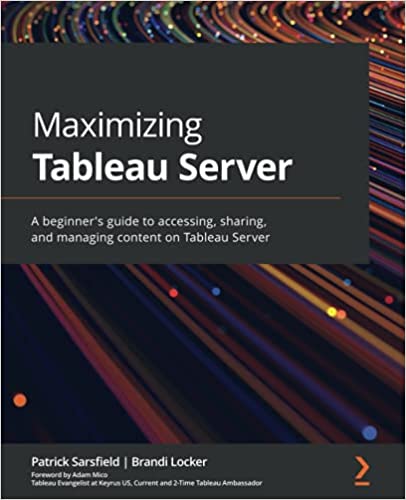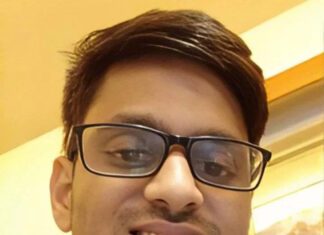Patrick Sarsfield is the author of Maximizing Tableau Server we got the chance to sit down with him and find out more about his experience of writing with Packt.
Q: What is/are your specialist tech area(s)?
Patrick : Data Visualization, Data Analytics, UI/UX, Cartography
Q: How did you become an author for Packt? Tell us about your journey. What was your motivation for writing this book?
Patrick : A Packt representative reached out to me and asked if I would be interested in writing a book on Tableau. I thought it sounded like a fun challenge, so I took advantage of the opportunity. My motivation for writing this book was to provide a resource that I wish I had when I was first getting started with Tableau.
Q: What kind of research did you do, and how long did you spend researching before beginning the book?
Patrick : Our initial experience was a result of hands-on experience at work, and our research consisted of reading up on and testing the available Tableau Server features. The research process took several weeks, and we understood early on that we would need to be flexible with adding, moving, and removing content from the initial book outline. I know it’s shocking, but receiving a book deal with a cash advance really helped incentivize me to explore and write about features in much greater detail than I probably otherwise would have.
Q: Did you face any challenges during the writing process? How did you overcome them?
Patrick : I decided to write this book amid a global pandemic while working from home with my kids in virtual school locked in a tiny home in the city. So, I imagine it was a pretty stereotypical writing experience. To overcome these obstacles, I drank lots of coffee and stayed up even later than usual.
Q: What’s your take on the technologies discussed in the book? Where do you see these technologies heading in the future?
Patrick : I think the days of manual data entry jobs are coming to an end. The ability to automate routine reports and create interactive dashboards allows analysts to spend most of their time analyzing data instead of updating reports or presentations. These changes are being driven by technologies like Tableau Desktop and Tableau Server/Online. I see these technologies and others disrupting the way legacy businesses currently operate and enabling motivated employees to spend their time on much more meaningful and rewarding work.
Q: Why should readers choose this book over others already on the market? How would you differentiate your book from its competition?
Patrick : Simple. One of the primary reasons we chose to write about this topic was because despite Tableau Server and Tableau Online being the way that most users are introduced to Tableau at work, no books for everyday users are available on the topic. The only Tableau Server books available are written for very niche audiences like Administrators and Server Installation. As a result, I can confidently say that this is the best book (and only) book available for regular Tableau Server users on the market.
Q. What are the key takeaways you want readers to come away from the book with?
Patrick : I want people to read this book and realize that there are so many easy ways to leverage Tableau Server and Tableau Online to reduce redundant tasks, drive user engagement, and improve efficiency. I also wanted to provide individuals new to Tableau with a roadmap to continue learning and help facilitate becoming a part of the Tableau Community.
Q. What advice would you give to readers learning tech? Do you have any top tips?
Patrick : I would recommend that readers concentrate on getting really good at a few things, rather than being mediocre at many. Ideally, you should focus on areas that you display some talent or have a latent interest. My top tip? Have fun. People are much more willing to spend time learning when it doesn’t feel like work.
Q. Do you have a blog that readers can follow?
Patrick : I am beginning to blog for my company, Lovelytics (https://lovelytics.com/), and you can find my vizzes on Tableau Public (https://public.tableau.com/app/profile/patrick.sarsfield).
Q. Can you share any blogs, websites and forums to help readers gain a holistic view of the tech they are learning?
Patrick : Below, in no particular order, are 3 of my avorite blogs for learning Tableau: • Adam Mico: https://adammico.medium.com • The Flerlage Twins: https://www.flerlagetwins.com • VizArtPandey: https://vizartpandey.com
Q. How would you describe your author journey with Packt? Would you recommend Packt to aspiring authors?
Patrick : My author journey with Packt has been a fun and interesting experience. I wanted to see if I could tackle the challenge of writing a book that would add value by filling a void and help others enter the broader Tableau community. I would recommend Packt to aspiring authors. Writing a book is a lot of work and having a publishing company with a proven track record, established methodologies, and an experienced team of editors, technical reviewers, and marketing coordinators really helps make the whole process much more manageable.
Q. Do you belong to any tech community groups?
Patrick : The Tableau Community and my local Tableau User Group.
Q. What are your favorite tech journals? How do you keep yourself up to date on tech?
Patrick : To keep up to date on technology I watch a lot of YouTube. My favorite channel to watch on advanced technologies, disruptive innovation, science, and finance is my friend Alex’s channel Ticker Symbol: YOU.
Q. How did you organize, plan, and prioritize your work and write the book?
Patrick : To begin, me and my co-author, Brandi Locker, worked hard to create a comprehensive outline. However, we realized that as we wrote the book, we would need to be flexible with adjusting the original outline to incorporate new material and reorganize where certain topics were introduced. Regarding planning this book, we intentionally decided to write the first chapters near the end of the book. Writing the book out of order might sound like a Quentin Tarantino movie, but it allowed us to write the introductory chapters with a clear understanding of what was in the book because we had already written most of it. Lastly, we allocated our writing portions based on who we thought would be best at tackling each topic or section. I typically would try to dedicate 2 hours every evening to the book. That time consisted of researching, testing, writing, proofreading, and creating images for the book.
Q. What is that one writing tip that you found most crucial and would like to share with aspiring authors?
Patrick : You don’t have to go it alone. I was so fortunate to get to write this book with a great friend who knew my strengths, accepted my weaknesses, and still decided to write a book with me. We held each other accountable, and we understood what the other person was going through if writing became difficult, deadlines were near, and life happened because we were going through the experience together.
You can find Patrick’s & Brandi’s book on Amazon by following this link: Please click here









